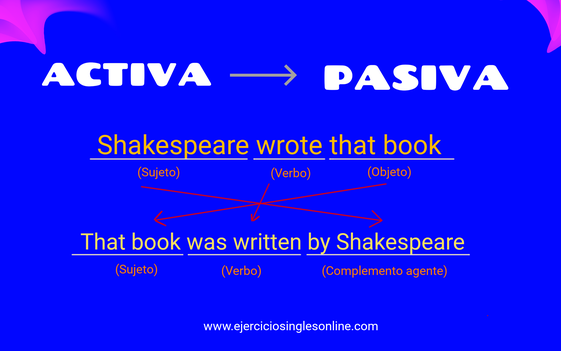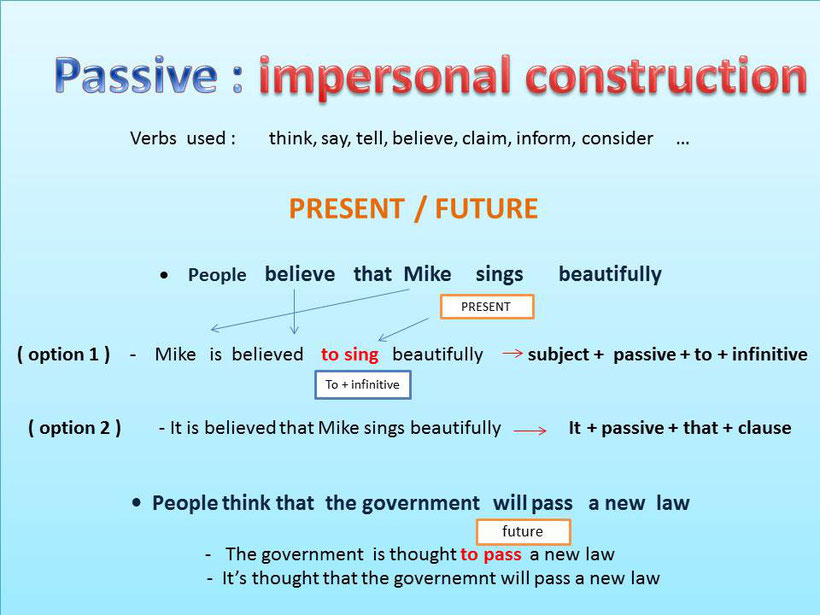VOZ PASIVA EN INGLÉS
Descripción: Voz pasiva en inglés. En el siguiente artículo te explicamos paso a paso como hacer una oración pasiva en inglés. También hemos creado una tabla de equivalencia activa-pasiva para puedas ver la diferencia que hay entre un tiempo verbal en voz activa o pasiva. Puedes acceder también a ejercicios de pasiva en inglés online. Recuerda que nuestro ejercicios tienen auto-corrección y puedes auto-evaluarte. También, puedes descargar ejercicios de pasiva en PDF en nuestra sección PDF ZONE. Si quieres acceder al mejor material interactivo relacionado con la voz pasiva te recomiendo echar un vistazo a nuestros artículos del BLOG referidos a este tema.
¿CÓMO HACER UNA ORACIÓN EN PASIVA?
PASOS PARA TRANSFORMAR UNA ORACIÓN PASIVA
Vamos a explicar como pasar una oración a pasiva a partir del siguiente ejemplo:
- The boy bouht the house - The house was bought (by the boy)
Primer paso: El objeto de la oración activa (que normalmente es la primera palabra o sintagma nominal que aparece después del verbo principal de la oración activa - the house se convierte en sujeto en la voz pasiva.
Segundo paso: Tenemos que escribir el verbo TO BE en la oración pasiva, en el mismo tiempo verbal que el verbo de la oración activa. Es decir, si el verbo de la oración activa está en presente, tenemos que poner am, is o are en la oración pasiva. Si el verbo principal de la activa está en pasado, pondríamos was o were, y si estuviese en futuro pondríamos will be.
Tercer paso: El verbo principal de la oración activa, se transforma en participio en la pasiva.
Cuarto paso: El sujeto de la oración activa (the boy) se convierte en complemento agente en la voz pasiva introducido por la preposición - by (by the boy)
ejercicios pasiva inglés
más ejercicios
Presente simple - Pasiva -
Ejercicio
Presente continuo - Pasiva - Ejercicio
Pasado simple - Pasiva -
Ejercicio
Pasado continuo - Pasiva - Ejercicio
Futuro simple -
Pasiva - Ejercicio
Futuro planeado - Pasiva - Ejercicio
Presente perfecto
simple - Pasiva - Ejercicio
Pasado perfecto simple - Pasiva - Ejercicio
Verbos modales
simples - Pasiva - Ejercicio
Verbos modales perfectos - Pasiva - Ejercicio
TABLA DE EQUIVALENCIA
ACTIVA VS PASIVA
Descripción: Tabla de equivalencia activa - pasiva en inglés. En el siguiente cuadro puedes observar la diferencia de formación entre la voz activa y la voz pasiva en inglés. De esta manera, te resultará más fácil identificar las diferencias de la formación de los tiempos verbales en ambas voces, activa y pasiva. Después, más abajo, puedes realizar nuestros ejercicios de pasiva online, con auto-corrección.
|
Tense: PRESENT SIMPLE Active: They buy the house. Passive: The house is bought (by them). |
|
Tense: PRESENT CONTINUOUS Active: They are buying the house. Passive: The house is being bought (by them). |
|
Tense: PAST SIMPLE Active: They bought the house. Passive: The house was bought (by them) |
|
Tense: PAST CONTINUOUS Active: They were buying the house. Passive: The house was being bought (by them) |
|
Tense: FUTURE SIMPLE Active: They will buy the house. Passive: The house will be bought (by them). |
|
Tense: PLANNED FUTURE Active: They are going to buy a house. Passive: They house is going to be bought (by them). |
|
Tense: PRESENT PERFECT SIMPLE Active: They have bought a house. Active: A house has been bought (by them). |
|
Tense: PAST PERFECT SIMPLE Active: They had bought a house. Passive: A house had been bought (by them). |
|
Tense: MODAL VERB Active: She must buy the house. Passive: The house must be bought (by them). |
|
Tense: MODAL PERFECT Active: She must have bought the house. Passive: The house must have been bought (by them). |



